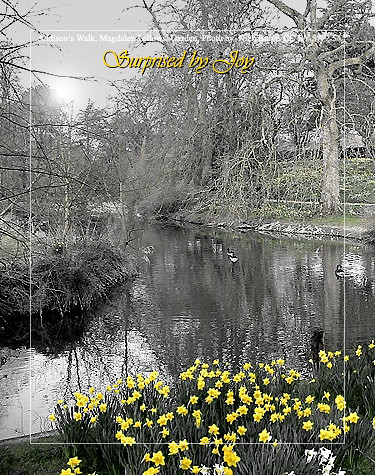
Volume XX, Issue Va: Surprised by Joy
Cover: Addison's Walk (originally called the Water Walk) is a picturesque footpath around a small island in the River Cherwell in the grounds of Magdalen College, Oxford, England. There are beautiful views of Magdalen Tower and Magdalen Bridge from along the walk. The walk is named after Joseph Addison (1672–1719), a Fellow of the College from 1698 to 1711, who enjoyed walking there and wrote articles in The Spectator about landscape gardening. The path most likely dates from the 16th century, although the name "Addison's Walk" has only been in use since the 19th century. Addison's Walk originally finished at Dover Pier, an old Civil War gun position on the River Cherwell. It was made into a circular walk in the 19th century. The walk is referenced frequently in Justin Cartwright's novel The Song Before it is Sung. Addison's Walk was a favourite walk of the author C. S. Lewis (1898–1963), who for much of his life was another Fellow of Magdalen College. He regularly frequented Addison's Walk with friends who included Hugo Dyson and J. R. R. Tolkien.
-- Wikipedia
Our childhoods shape how we see the world. Our early experiences help define for us the struggle and the place of Faith in our lives. Here is an excellent piece on C. S. Lewis's observations on his own childhood and what he learned.
C. S. Lewis's story of his own journey to Faith. There is commentary by Francis Collins.
Lewis describes the discoveries of his own childhood and how they coloured his coming to Faith. The simple creation by his brother Warnie of a garden in a box opened up the perception of joy and natural beauty to the young 'Jack,' who in his earliest days combined his love of knights in armor and 'dressed animals' to write fanciful stories.
Years later, he and his fellow 'Inklings' would return to such fancies to write the literature they felt no one else was writing. Their work forever enriched the literature of modern times, giving us Middle Earth and Narnia! Their work overlaid the modern 'world of reason' with the proper workings of Imagination and Meaning.
The Life of George Whitefield
[click to read]
by Josh Nielsen
George Whitefield was born in the Bell Inn in Gloucester, England on December 16, 1714. His father, Thomas, was the innkeeper there and was also a wine merchant (Anglican Library). Whitefield often made use of the events of his birth in his sermons later on in his life to “magnify” (Ruttenburg 437) his humble beginnings, though far from being prideful, saying that his nativity followed after “the example of [his] dear Saviour, who was born in a manger belonging to an inn” (Lambert 228-229). Lambert also says that Whitefield defended his autobiography against those who thought it presumptuous to parallel himself with Christ, declaring that “‘the Circumstance of my being born in an Inn has often been of Service to me’ in introducing men and women to the new birth” (229).
George was the youngest of seven children in his family. His father died when he was only two years old and his mother then struggled to provide for her family and run the inn (Anglican Library). George went off to St. Mary de Crypt Grammar School when he was twelve where he “earned a reputation as an actor and orator, but also a[s] a persistent truant” (A short biography of George Whitefield). Believing he would never make a use of his education, at age 15, he talked his mother into allowing him to drop school and help work in the inn (ibid).
One day a student from Oxford visited the inn and spoke to his Mother about how he worked his way through college, and it encouraged George to return to grammar school so he could attend Oxford (Anglican Library). After another year he then went on to Oxford where “he was enabled to attend despite humble family circumstances… by acting as servitor to a number of wealthy students” (Ruttenburg 432). Going to Oxford turned out to be a life changing experience for Whitefield. (read more)
"Safe Danger," The Studio Path
[click to read]
Creating a Journey in a Garden Walk
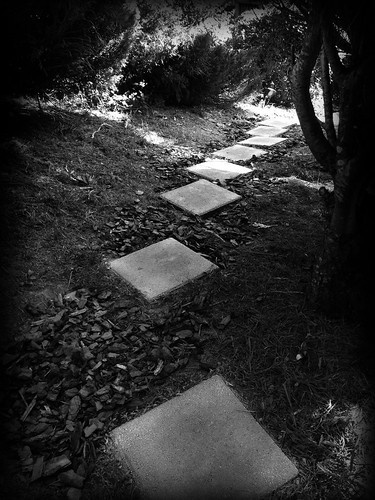
Phillip Johnson, the architect famous for his 'Glass House' also created on his Connecticut estate a monument to his college friend Lincoln Kirstien. Kirstien was a poet, connoisseur, philanthropist, and cultural figure in New York City. He helped found the New York City Ballet. Johnson's monument to his friend, the Kirstien Tower, is a steep stairway of stepping stones into the Heavens. A fitting tribute to a creative spirit!
In describing the tower, Johnson refers to the term 'Safe Danger.' Indeed the steep ascent requires stepping into the unknown and creates a feeling of excitement. Every venture into the creative world should. Thus the pathway to my studio, originally created by the need for an economical solution became a similar stairway into creative wonder. I don't think the Kirstien Tower was a direct inspiration so much as a wondrous connection to my own bit of 'Safe Danger.' (read more)
The Soldier Bear
Wojtek, the Soldier Bear actually fought in World War II with a unit of the Polish Army!
The America I Love
Photos by Bob Kirchman
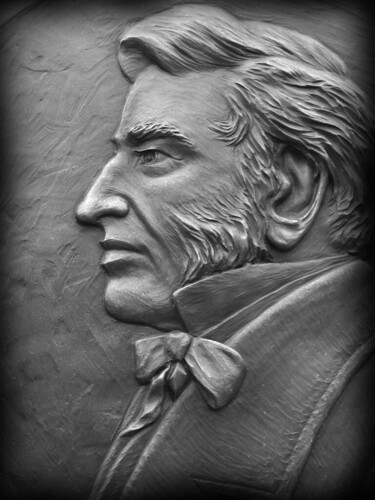
Bas relief of Claudius Crozet, engineer of the Blue Ridge Tunnel, at Virginia Military Institute in Lexington, Virginia.

The grave of Traveller, Robert E. Lee's war horse, beside Lee Chapel in Lexington, Virginia.

Waterslide, Massanutten, Virginia.
James 3
Not many of you should become teachers, my brothers, since you know that we will be judged more severely. For we all stumble in many ways; if someone does not stumble in what he says, he is a mature man who can bridle his whole body. If we put a bit into a horse’s mouth to make it obey us, we control its whole body as well. And think of a ship — although it is huge and is driven by strong winds, yet the pilot can steer it wherever he wants with just a small rudder. So too the tongue is a tiny part of the body, yet it boasts great things. See how a little fire sets a whole forest ablaze! Yes, the tongue is a fire, a world of wickedness. The tongue is so placed in our body that it defiles every part of it, setting ablaze the whole of our life; and it is set on fire by Gei-Hinnom itself. For people have tamed and continue to tame all kinds of animals, birds, reptiles and sea creatures; but the tongue no one can tame — it is an unstable and evil thing, full of death-dealing poison! With it we bless Adonai, the Father; and with it we curse people, who were made in the image of God. Out of the same mouth come blessing and cursing! Brothers, it isn’t right for things to be this way. A spring doesn’t send both fresh and bitter water from the same opening, does it? Can a fig tree yield olives, my brothers? or a grapevine, figs? Neither does salt water produce fresh. Who among you is wise and understanding? Let him demonstrate it by his good way of life, by actions done in the humility that grows out of wisdom. But if you harbor in your hearts bitter jealousy and selfish ambition, don’t boast and attack the truth with lies! This wisdom is not the kind that comes down from above; on the contrary, it is worldly, unspiritual, demonic. For where there are jealousy and selfish ambition, there will be disharmony and every foul practice. But the wisdom from above is, first of all, pure, then peaceful, kind, open to reason, full of mercy and good fruits, without partiality and without hypocrisy. And peacemakers who sow seed in peace raise a harvest of righteousness.”
I am reading Jedidiah Jenkins’s book To Shake the Sleeping Self. Jenkins is the son of Peter and Barbara Jenkins, who walked across America and into stardom in the Evangelical community. I enjoyed their books about the walk across the country and The Road Unseen, a book about their journey from a spiritual perspective. Jedidiah follows in his father’s footsteps, setting out to ‘find himself’ by bicycling with his friend Weston from Oregon to Patagonia. The travelogue portion of the book is fascinating. The ‘personal discovery’ portion too soon retreats into millennial clichés. Cycling into the Baja, the two adventurers quickly become overwhelmed as Weston destroys a wheel of his bicycle. Jedidiah prays and the answer comes in the form of a friendly gentleman who invites them into his home and arranges for them to find a repair shop. Here Jenkins, who admits to missing the comforts of California, finds himself in a simple two room adobe house where the father longs to send his children to America. Here Jedidiah, instead of celebrating the hope that America is to so many in the world, launches into a Howard Zinn inspired rant about the evil America. This is ironic because almost in the same breath he can’t wait to return to its comforts. Nonetheless, he parrots the narrative of so many of his age – deriding the society that was able to give hope and comfort to the world. Jenkins is also going to wrestle with spiritual matters, the book seems to promise, but such discussions end quickly and Weston rolls himself another joint. In the end, Jenkins will say that he’s not thinking of the heavy questions and that is fine.
And so I am enjoying the book more as a travelogue. I’m wondering how they’ll make it through the Darien Gap – a seventy mile stretch of jungle between Panama and Columbia. There is no road there because guerrilla forces move about there. He and Weston will take a sailboat around the area and the most hair raising part of that adventure will be an issue over a missing visa stamp. For the most part, that still makes for good reading. “Not many of you should become teachers,” James 3 warns. And to his credit, Jedidiah does not teach much. He raises some questions but quickly moves on. Jenkins may be going off to ‘find himself,’ but he’s not digging too deep. Some critics call him a “Mystic Millenial,” but rather than engage in deep soul-searching, he seems to accept his disjointed life as it is and in doing so invites his fellow travelers to “go no farther.” If Jenkins indeed invites fellow pilgrims to “go no farther,” though, he is really not heeding the advice of James. In fact, he is following somewhat in the footsteps of his father. He is not addressing the problems that supposedly vex him. He offers no great light or wisdom, inferring that it probably doesn't exist anyway.
In his first book's first chapter, Peter Jenkins talks about his first failing marriage as he retreated to the pottery studio and eventually decided to walk across the continent. He “found Jesus” at a revival crusade, pushed on across the country, married a girl he barely knew and rocketed to Evangelical celebrity. He and Barbara were favorite guests of James Dobson. I read all three of their books about the walk and loved them. Jenkins could write and travel, he carried you along with him as he interacted with amazing and interesting people. He excelled at it. But a while later I picked up a book about him journeying through China and something in me said “this is just wrong.” Here he was with young children and a wife needing his support on the farm that they once celebrated as a gift from God, and he’s off on another adventure. Sure enough, it seems he never found healing for the first chapter of his first book. He started cheating on Barbara and she kicked him out. The appearances on Christian media dried up. Another ‘Evangelical Leader’ had fallen.
When Paul was apprehended by Jesus on the Damascus Road, he didn’t immediately become the Apostle, rather he spent a considerable time in Damascus as a disciple. He had been taught extensively at the feet of Gamaliel but he needed to go into obscurity to learn the ways of Redemption in Christ. Peter Jenkins went directly to celebrity status without those years of learning and healing. His family suffered from it. My Redemption is a lesson I am still working on learning.. Last year a student asked me to tell the story of how I came to Christ. For me it was a very sobering question, for I am still coming to Christ – still learning. I hope I was able to convey that reality to her. Paul himself said that he had not arrived, but rather: “I press toward the mark for the prize of the high calling of God in Christ Jesus.!” Here is a journey I can share! I pray that one day Jedidiah Jenkins will set his prow straight into the waves and make that brave journey into faith. Then his story will be complete.
The great Christian apologist C. S. Lewis had many questions too. When his mother died and his father became distant he abandoned the beliefs of his youth. After a terrible boarding school experience, his father arranged for him to have a private tutor – a confirmed atheist. William Thompson Kirkpatrick taught Lewis to reason impeccably but could not answer the deep longings of his young pupil’s heart. Lewis was willing to face those longings, reasoning that “If I find in myself a desire which no experience in this world can satisfy, the most probable explanation is that I was made for another world.” That reasoning would frame for Lewis a new quest. Along with the mentorship of his friends J. R. R. Tolkien and Owen Barfield it would lead him to the deep faith that he is known for so eloquently unfolding in his writings. “The Christian says, 'Creatures are not born with desires unless satisfaction for those desires exists. A baby feels hunger: well, there is such a thing as food. A duckling wants to swim: well, there is such a thing as water. Men feel sexual desire: well, there is such a thing as sex. If I find in myself a desire which no experience in this world can satisfy, the most probable explanation is that I was made for another world. If none of my earthly pleasures satisfy it, that does not prove that the universe is a fraud. Probably earthly pleasures were never meant to satisfy it, but only to arouse it, to suggest the real thing. If that is so, I must take care, on the one hand, never to despise, or to be unthankful for, these earthly blessings, and on the other, never to mistake them for the something else of which they are only a kind of copy, or echo, or mirage. I must keep alive in myself the desire for my true country, which I shall not find till after death; I must never let it get snowed under or turned aside; I must make it the main object of life to press on to that country and to help others to do the same.”― C.S. Lewis, Mere Christianity

Magic Garden Visitor. Photo by Bob Kirchman
J. R. R. Tolkien and C. S. Lewis
Reconciling Reason and Imagination
Two friends, J. R. R. Tolkien and C. S. Lewis had a common love of the great myth. The two observed that for many centuries cultures communicated their greatest truths through myth and legend. They lamented the rational society they lived in’s relegation of these myths to ‘children’s stories,’ as they knew grown men and women… even great warriors relished these tales and the great thoughts they conveyed. These tales connected emotionally with their readers and tellers. These stories contained great insight into life and truth that could be observed as well as providing a glimpse into the world unseen, the spiritual realm.
Before coming to faith in Christ, Lewis lamented to Tolkien that it was a shame that the great myths were not true. Tolkien responded that they indeed contained great truths, and walking on Addison’s Walk on the grounds of Magdalen College, Tolkien helped the struggling Lewis reconcile reason and imagination. “The Gospels had all the qualities of great human storytelling. But they portrayed a true event - God the storyteller entered his own story, in the flesh, and brought a joyous conclusion from a tragic situation. Suddenly Lewis could see that the nourishment he had always received from great myths and fantasy stories was a taste of the greatest, truest story — of the life, death and resurrection of Christ.” —Chris Armstrong writes in Christianity Today. Lewis and Tolkien insisted that reason and imagination must be integrated — in any understanding of truth, the whole person must be satisfied.
In 1936 J. R. R. Tolkien had just written The Hobbit and the two friends began to think of a scheme to reignite myth in modern culture. They decided upon science fiction as a vehicle of ‘modern myth’ and assigned themselves topics that would inspire serious works for modern readers. Lewis would write about ‘Space Travel’ and Tolkien ‘Time Travel.’ Out of the Silent Planet, Perelandra, and That Hideous Strength — the “Space Trilogy” or the “Ransom Trilogy” was Lewis’s offering for ‘Space Travel.’ It fictionalizes a very serious line of thought that he develops in The Abolition of Man, which is really just the publication of a series of lectures he delivered.
Tolkien’s Trilogy became The Lord of the Rings and departed somewhat from the assignment, but it is a great work that has become a classic mythology for modern readers. Tolkien and Lewis sought most of all to bring the type of literature they themselves loved to modern readers. Tolkien himself said to Lewis: “I relish stories that survey the depths of space and time.” I discovered Lewis’s Narnia as a young adult and it brought me to a deeper feeling/understanding of my own faith. My young granddaughter knows these stories as a child and her world is the richer for it. In my youth I had read quite a bit of Jules Verne’s Voyages Extraordinaire and they certainly fueled my imagination. In Around the World in Eighty Days he deals not so much with time travel per se, but the concept of global travel and the ‘lost’ day.

The Inuit live on both sides of the International Date Line. Before travel was restricted by the world's two great superpowers they could literally cross the Bering Strait into another day. Journey to Jesus Mural by Kristina Elaine Greer and Bob Kirchman
Looking at a mural that I was painting with Kristina Elaine Greer of the world’s children ‘around the globe’ that point where you can literally ‘step into tomorrow’ became the inspiration for what I originally intended as a short story — Dinner Stop at the End of the World which originally offered itself as an alternative to some of the dystopian apocalyptic ‘Christian’ literature that was coming out at the time. I was notably concerned that there were people in Bible studies I knew taking all too seriously the work of one author in particular who mixed mysticism with prophecy to create a bit of an alarmist message as his protagonist would continually meet a mysterious ‘prophet’ figure who would give him a new piece of the ‘puzzle’ concerning the judgement of America. It was an intriguing work of fiction — not much on plot, mind you, but it did get you thinking about Biblical prophecy. The problems I had with it were twofold, first of all it created a dark scenario and did not offer much in the way of light or hope. Secondly, it based much of its proclamations not so much on scripture but a form of mysticism that is found in Judaism.
It wasn’t that great a story. Still, the author was appearing on Jim Bakker’s show (yes, he’s still around) and his message was punctuated by advertisements for ‘survival food.’ The publisher produced a companion ‘study guide.’ People were actually directing their lives in response to an interesting work of fiction! What I found tragic was that we were putting aside the inspiration of the younger generation who must have dismissed a lot of this adult behavior as ‘over the top.’ I’m not writing this to dump on someone who’s published a lot of books but rather to say that he did me one great favor — he pushed me to write out of my own imagination and yes a sense of reason that is rooted in the 23rd Psalm which states that “The Lord is my shepherd.” That drove me to do my own study of history. I found that though indeed there were terrible things that sinful man had done, there were the great stories of Redemption as well. Redemption, I would discover, is the ultimate story of time travel for it takes us from death to life — from finite existence to the very doorway to eternity. my own little story grew into PONTIFUS.
APOLLONIUS is my attempt to delve into ’Space Travel.’ As in PONTIFUS, I find myself looking to Lewis a lot… as to Jules Verne who had been my inspiration in youth. I used to draw fanciful flying machines and such. But in all of this, I rather liken to fancy a conversation ongoing at ‘Eagle and Child’ that can inspire us even in our day. Sitting on top of a mountain in Shenandoah Park with my friend Ebenezer Murengezi, we met a hiker. He walked up to the place we were sitting — a gentleman from Alaska, the son of dairy farmers, and he was hiking the entire Appalachian Trail. We were enjoying pleasant conversation when Ebenezer and I remarked at how much nature showed you the wonder of God. “What do you think?” Ebenezer asked the gentleman. “I’m a scientist.” he replied. By that he meant he had no use for our “fables.” He said he had believed as a child but that he was taught “better” by the university he attended. I asked him if he’d ever simply asked God to show Himself to him and he said “I’ve already been there.” I replied “Perhaps God hasn’t finished yet.” At this point the poor gentleman made a hasty exit. I bring this up merely to point out that I DON’T think the issue was resolved for him. In the realm of Reason, God had been discarded. In the realm of Imagination, however, questions had NOT been sufficiently put to rest.
Lewis had his childhood faith put to rest by his mentor William Kirkpatrick, or "The Great Knock," who appears in the Narnia books as Digory Kirk — and far more open to possibilities beyond our world because he’s been there. It was that time of rediscovery with Tolkien that brought C. S. Lewis to great faith. I pray that the gentleman we met on the mountain will find his J. R. R. Tolkien, The resolution of reason and imagination, and most of all FAITH!
Magnolia Blossom
Photos by Bob Kirchman
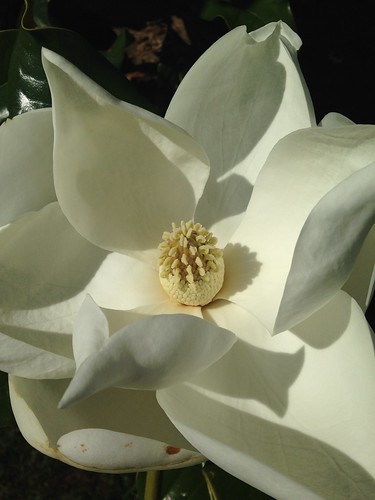


Day Lily
Photos by Bob Kirchman



A Tale of Two Teachers
[click to read]
By Amber Lee Keller
A while ago I went to a women’s conference in another state with some of my relatives. We heard two different Bible teachers speak. Both of these women had written books. Both were well known. That is where the similarities ended. One women was older. In fact, she was in her eighties. She spoke first. She shared her heart for us younger women. She shared from the Word. She spoke of women to whom she had ministered in countries where believers are being persecuted. Her voice broke as she spoke of her sisters in Christ, living under the constant threat of imprisonment and death. You could see the love she carried for them. She spoke of Christ and the gospel. Her knowledge of the Word was so evident, and her talk was so full of scripture that she just seemed to breathe it out. I left her session with a heart yearning for Christ. I left with a clear picture of what I want to look like if the Lord should give me the gift of old age. Decades of walking with Jesus had made her one of the most wise and gentle-spirited women I have ever seen. (read more)
Bishop Robert Barron on Luke 8:16,18
No man, when he hath lighted a candle, covereth it with a vessel, or putteth it under a bed; but setteth it on a candlestick, that they which enter in may see the light. Take heed therefore how ye hear: for whosoever hath, to him shall be given; and whosoever hath not, from him shall be taken even that which he seemeth to have.” – Luke 8:16, 18
Friends, today’s Gospel is the parable of the lamp which, placed on a lampstand, gives light to all. Light obviously isn’t for itself; rather, we see things by it. It illuminates things upon which it shines.
We are light by which people around us come to see what is worth seeing. By the very quality and integrity of our lives, we shed light, illumining what is beautiful and revealing what is ugly. The clear implication is that without vibrant Christians the world is a much worse place. Let me illustrate this principle with an example. One of the most painful truths of the last century is that the weakness of Christian witness allows some of the worst elements in society to flourish.
Think of the rise of the evil powers that created World War II. Christianity had become so weak, so uncompelling, so attenuated that great evil was allowed to flourish. Yes, indeed there were a handful of powerful Christian resisters, but let’s face it: the overwhelmingly vast majority of Christians either supported Hitler or remained in silence, out of either fear or indifference.
Presidential Call to National Day of Prayer
In our times of greatest need, Americans have always turned to prayer to help guide us through trials and periods of uncertainty. As we continue to face the unique challenges posed by the coronavirus pandemic, millions of Americans are unable to gather in their churches, temples, synagogues, mosques, and other houses of worship. But in this time we must not cease asking God for added wisdom, comfort, and strength, and we must especially pray for those who have suffered harm or who have lost loved ones. I ask you to join me in a day of prayer for all people who have been affected by the coronavirus pandemic and to pray for God’s healing hand to be placed on the people of our Nation. As your President, I ask you to pray for the health and well-being of your fellow Americans and to remember that no problem is too big for God to handle. We should all take to heart the holy words found in 1 Peter 5:7: “Casting all your care upon him, for he careth for you.” Let us pray that all those affected by the virus will feel the presence of our Lord’s protection and love during this time. With God’s help, we will overcome this threat.
On Friday, I declared a national emergency and took other bold actions to help deploy the full power of the Federal Government to assist with efforts to combat the coronavirus pandemic. I now encourage all Americans to pray for those on the front lines of the response, especially our Nation’s outstanding medical professionals and public health officials who are working tirelessly to protect all of us from the coronavirus and treat patients who are infected; all of our courageous first responders, National Guard, and dedicated individuals who are working to ensure the health and safety of our communities; and our Federal, State, and local leaders. We are confident that He will provide them with the wisdom they need to make difficult decisions and take decisive actions to protect Americans all across the country. As we come to our Father in prayer, we remember the words found in Psalm 91: “He is my refuge and my fortress: my God; in him will I trust.”
As we unite in prayer, we are reminded that there is no burden too heavy for God to lift or for this country to bear with His help. Luke 1:37 promises that “For with God nothing shall be impossible,” and those words are just as true today as they have ever been. As one Nation under God, we are greater than the hardships we face, and through prayer and acts of compassion and love, we will rise to this challenge and emerge stronger and more united than ever before. May God bless each of you, and may God bless the United States of America.
NOW, THEREFORE, I, DONALD J. TRUMP, President of the United States of America, do hereby proclaim March 15, 2020, as a National Day of Prayer for All Americans Affected by the Coronavirus Pandemic and for our National Response Efforts. I urge Americans of all faiths and religious traditions and backgrounds to offer prayers for all those affected, including people who have suffered harm or lost loved ones.
IN WITNESS WHEREOF, I have hereunto set my hand this fourteenth day of March, in the year of our Lord two thousand twenty, and of the Independence of the United States of America the two hundred and forty-fourth.
DONALD J. TRUMP
Pictures of Redemption
Stations of the Cross for Children

“Pieta” of Jesus and Mary Painted by Vincent Van Gogh in 1890.
Christ alone, of all the philosophers, magicians, etc., has affirmed eternal life as the most important certainty, the infinity of time, the futility of death, the necessity and purpose of serenity and devotion. He lived serenely, as an artist greater than all other artists, scorning marble and clay and paint, working in the living flesh. In other words, this peerless artist, scarcely conceivable with the blunt instrument of our modern, nervous and obtuse brains, made neither statues nor paintings nor books. He maintained in no uncertain terms that he made…living men, immortals.” – Vincent van Gogh in a Letter to Emil Bernard on June 26,1988.
I went with my oldest granddaughter to Stations of the Cross for Children at St. Francis’s Church in Staunton. I’d forgotten the richness of a simple retelling of Christ’s Passion with fourteen visual images. Young people took turns reading the narrative which shows the extent of Jesus’ suffering for our redemption proceeding from bas-relief image to image around the sanctuary. The Gospel account becomes visual and one can imagine the pain and sacrifice beginning with Jesus’ condemnation and ending with his burial. It is a fitting prelude to the great mystery of Resurrection celebrated at Easter.
First Station: Jesus in the Garden of Gethsemane
Then Jesus came with them to a place called Gethsemane, and he said to his disciples, "Sit here while I go over there and pray." He took along Peter and the two sons of Zebedee, and began to feel sorrow and distress. Then he said to them, "My soul is sorrowful even to death. Remain here and keep watch with me." He advanced a little and fell prostrate in prayer, saying, "My Father, if it is possible, let this cup pass from me; yet, not as I will, but as you will." When he returned to his disciples he found them asleep. He said to Peter, "So you could not keep watch with me for one hour? Watch and pray that you may not undergo the test. The spirit is willing, but the flesh is weak." (Matthew 26:36-41)
Second Station: Jesus, Betrayed by Judas, is Arrested
Then, while [Jesus] was still speaking, Judas, one of the Twelve, arrived, accompanied by a crowd with swords and clubs, who had come from the chief priests, the scribes, and the elders. His betrayer had arranged a signal with them, saying, "the man I shall kiss is the one; arrest him and lead him away securely." He came and immediately went over to him and said, "Rabbi." And he kissed him. At this they laid hands on him and arrested him. (Mark 14: 43-46)
Third Station: Jesus is Condemned by the Sanhedrin
When day came the council of elders of the people met, both chief priests and scribes, and they brought him before their Sanhedrin. They said, "If you are the Messiah, tell us," but he replied to them, "If I tell you, you will not believe, and if I question, you will not respond. But from this time on the Son of Man will be seated at the right hand of the power of God." They all asked, "Are you then the Son of God?" He replied to them, "You say that I am." Then they said, "What further need have we for testimony? We have heard it from his own mouth." (Luke 22: 66-71)
Fourth Station: Jesus is Denied by Peter
Now Peter was sitting outside in the courtyard. One of the maids came over to him and said, "You too were with Jesus the Galilean." But he denied it in front of everyone, saying, "I do not know what you are talking about!" As he went out to the gate, another girl saw him and said to those who were there, "This man was with Jesus the Nazorean." Again he denied it with an oath, "I do not know the man!" A little later the bystanders came over and said to Peter, "Surely you too are one of them; even your speech gives you away." At that he began to curse and to swear, "I do not know the man." And immediately a cock crowed. Then Peter remembered the word that Jesus had spoken: "Before the cock crows you will deny me three times." He went out and began to weep bitterly. (Matthew 26: 69-75)
Fifth Station: Jesus is Judged by Pilate
The chief priests with the elders and the scribes, that is, the whole Sanhedrin, held a council. They bound Jesus, led him away, and handed him over to Pilate. Pilate questioned him, "Are you the king of the Jews?" He said to him in reply, "You say so." The chief priests accused him of many things. Again Pilate questioned him, "Have you no answer? See how many things they accuse you of." Jesus gave him no further answer, so that Pilate was amazed.... Pilate, wishing to satisfy the crowd, released Barrabas... [and] handed [Jesus] over to be crucified. (Mark 15: 1-5, 15)
Sixth Station: Jesus is Scourged and Crowned with Thorns
Then Pilate took Jesus and had him scourged. And the soldiers wove a crown out of thorns and placed it on his head, and clothed him in a purple cloak, and they came to him and said,"Hail, King of the Jews!" And they struck him repeatedly. (John 19: 1-3)
Seventh Station: Jesus Bears the Cross
When the chief priests and the guards saw [Jesus] they cried out, "Crucify him, crucify him!" Pilate said to them, "Take him yourselves and crucify him. I find no guilt in him." ... They cried out, "Take him away, take him away! Crucify him!" Pilate said to them, "Shall I crucify your king?" The chief priests answered, "We have no king but Caesar." Then he handed him over to them to be crucified. So they took Jesus, and carrying the cross himself he went out to what is called the Place of the Skull, in Hebrew, Golgotha. (John 19: 6, 15-17)
Eighth Station: Jesus is Helped by Simon the Cyrenian to Carry the Cross
They pressed into service a passer-by, Simon, a Cyrenian, who was coming in from the country, the father of Alexander and Rufus, to carry his cross. (Mark 15: 21)
Ninth Station: Jesus Meets the Women of Jerusalem
A large crowd of people followed Jesus, including many women who mourned and lamented him. Jesus turned to them and said, "Daughters of Jerusalem, do not weep for me; weep instead for yourselves and for your children, for indeed, the days are coming when people will say, 'Blessed are the barren, the wombs that never bore and the breasts that never nursed.' At that time, people will say to the mountains, 'Fall upon us!' and to the hills, 'Cover us!' for if these things are done when the wood is green what will happen when it is dry?" (Luke 23: 27-31)
Tenth Station: Jesus is Crucified
When they came to the place called the Skull, they crucified him and the criminals there, one on his right, the other on his left. [Then Jesus said, "Father, forgive them, they know not what they do."] (Luke 23: 33-34)
Eleventh Station: Jesus Promises His Kingdom to the Good Thief
Now one of the criminals hanging there reviled Jesus, saying, "Are you not the Messiah? Save yourself and us." The other, however, rebuking him, said in reply, "Have you no fear of God, for you are subject to the same condemnation? And indeed, we have been condemned justly, for the sentence we received corresponds to our crimes, but this man has done nothing criminal." Then he said, "Jesus, remember me when you come into your kingdom." He replied to him, "Amen, I say to you, today you will be with me in Paradise." (Luke 23: 39-43)
Twelfth Station: Jesus Speaks to His Mother and the Disciple
Standing by the cross of Jesus were his mother and his mother's sister, Mary the wife of Clopas, and Mary of Magdala. When Jesus saw his mother and the disciple there whom he loved, he said to his mother, "Woman, behold, your son." Then he said to the disciple, "Behold, your mother." And from that hour the disciple took her into his home. John 19: 25-27
Thirteenth Station: Jesus Dies on the Cross
It was now about noon and darkness came over the whole land until three in the afternoon because of an eclipse of the sun. Then the veil of the temple was torn down the middle. Jesus cried out in a loud voice, "Father, into your hands I commend my spirit"; and when he had said this he breathed his last. (Luke 23: 44-46)
Fourteenth Station: Jesus is Placed in the Tomb
When it was evening, there came a rich man from Arimathea named Joseph, who was himself a disciple of Jesus. He went to Pilate and asked for the body of Jesus; then Pilate ordered it to be handed over. Taking the body, Joseph wrapped it [in] clean linen and laid it in his new tomb that he had hewn in the rock. Then he rolled a huge stone across the entrance to the tomb and departed. (Matthew 27: 57-60)
Closing Prayer:
Lord Jesus Christ, your passion and death is the sacrifice that unites earth and heaven and reconciles all people to you. May we who have faithfully reflected on these mysteries follow in your steps and so come to share your glory in heaven where you live and reign with the Father and the Holy Spirit one God, for ever and ever.
Amen.
Vincent van Gogh’s Unappreciated
Journey with Christ
By Mark Ellis
[click to read]
A record 1.2 million visitors came to the giant retrospective of Van Gogh’s work in Amsterdam in 1990, which coincided with the 100th anniversary of the Dutch post-Impressionist’s death. What visitors did not see at that major exhibition were van Gogh’s Christian-themed paintings, which were left in the basement of the museum. (read more)
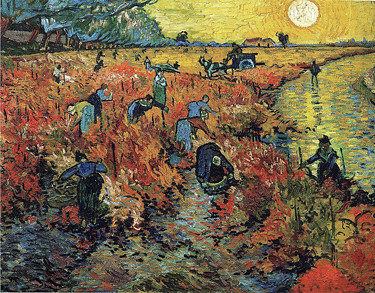
The Red Vineyards near Arles is an oil painting by the Dutch painter Vincent van Gogh, executed on a privately primed Toile de 30 piece of burlap in early November 1888. It is reported to be the only piece sold by the artist while he was alive. Savhanna Herndon
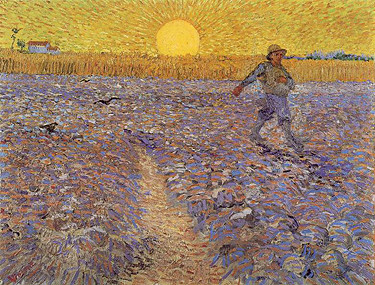
“I don’t hide from you that I don’t detest the countryside — having been brought up there, snatches of memories from past times, yearnings for that infinite of which the Sower, the sheaf, are the symbols, still enchant me as before.” (Letter 628 to his friend and painter Émile Bernard, on or about June 19, 1888).
Vincent Van Gogh, Le semeur (The Sower), Mid-June 1888. Oil on canvas, 64 x 80,5 cm. Kröller-Müller Museum,The Netherlands
The World’s Great Art
[click to read]
2,500 Museums You Can Now Visit Virtually
If you’re feeling hungry for art while you’re stranded at home, here are 12 selections out of 2,500 world-class museums and galleries that are now offering virtual tours and online collections. (read more)
[Click to Read]
